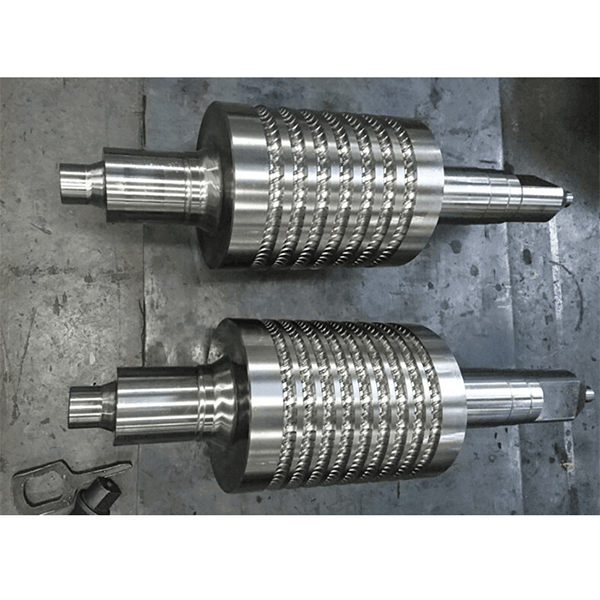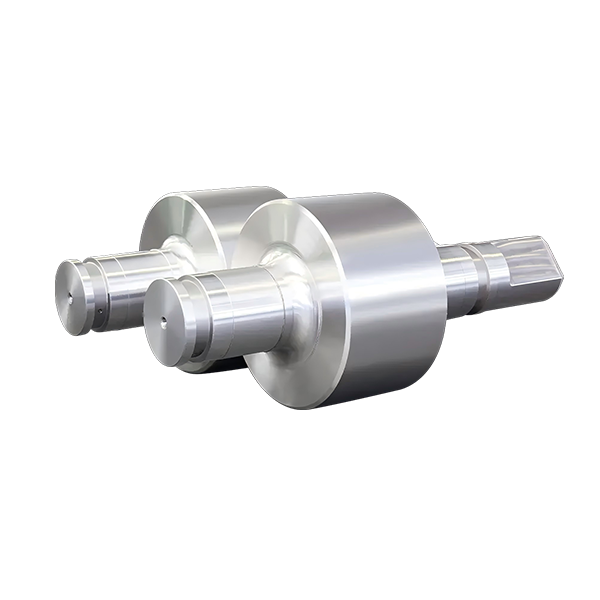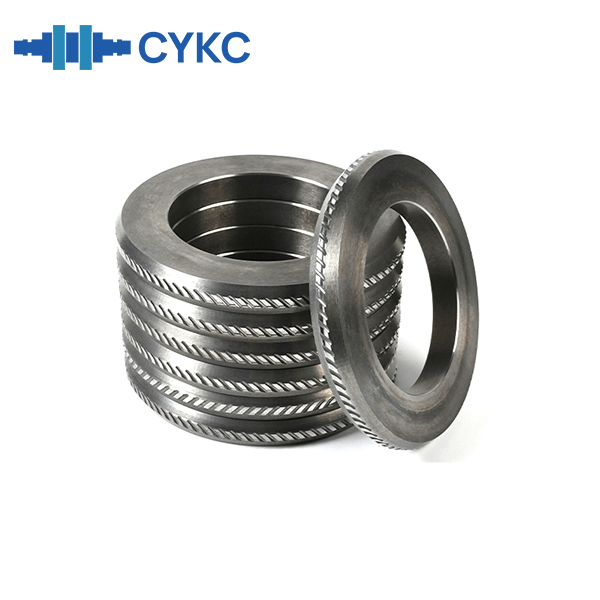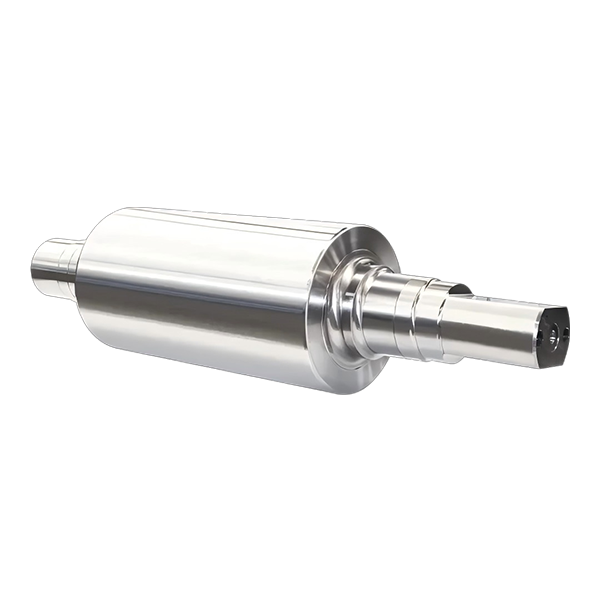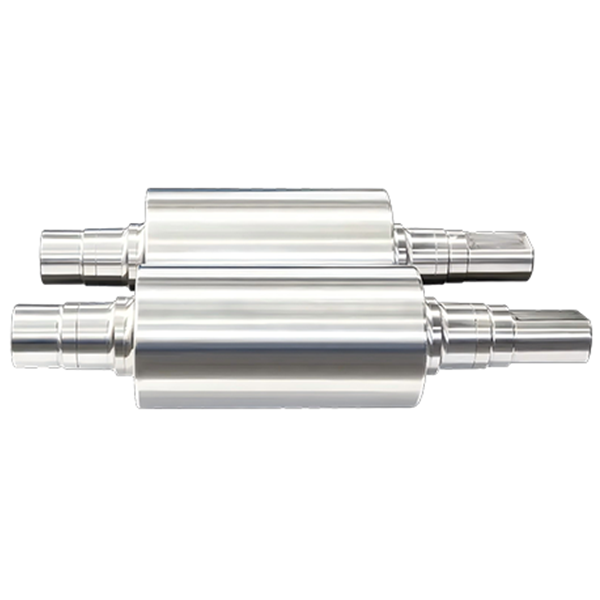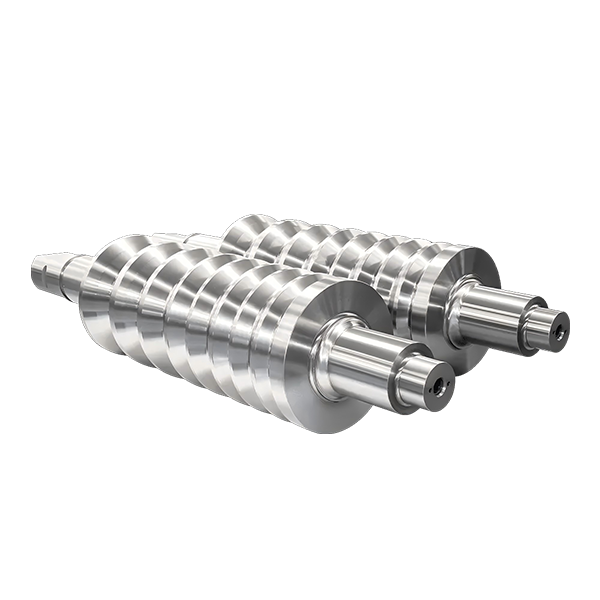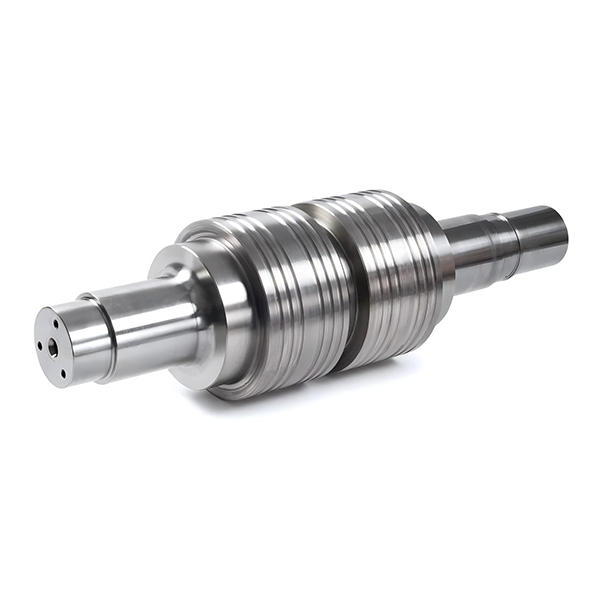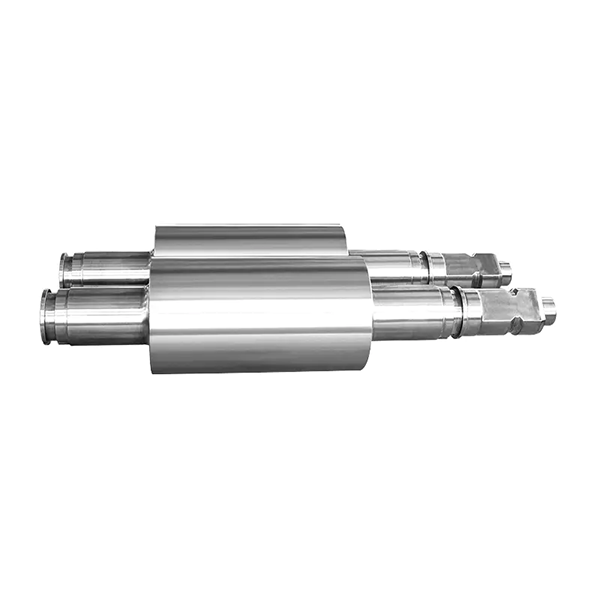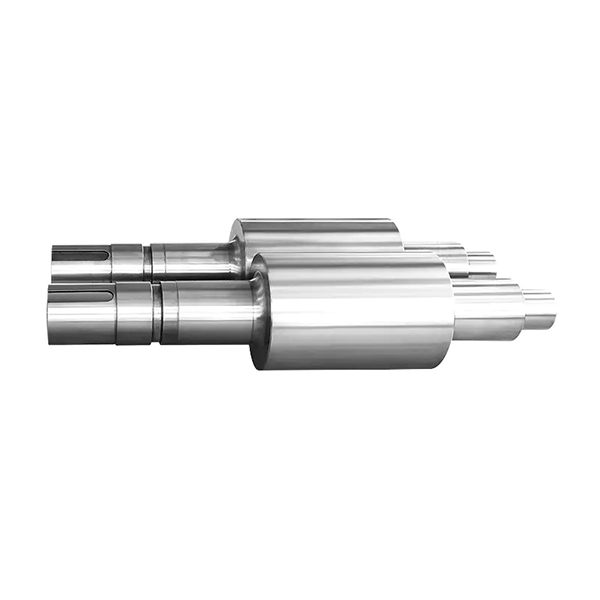The commonly used materials for hot-rolling rolls include 55Mn2, 55Cr, 60CrMnMo, 60SiMnMo, etc. Hot-rolling rolls are used in the processing of billets, thick plates, section steel, etc. They are subjected to strong rolling forces, severe wear and thermal fatigue effects. Moreover, hot-rolling rolls operate at high temperatures and allow diameter wear within a unit of work, so surface hardness is not required. Only high strength, toughness and heat resistance are required. Hot-rolled rolls are only subjected to overall normalizing or quenching, and the surface hardness requirement is HB190 to 270 hardness.Relevant Definitions.
Rolls are tools that cause plastic deformation of metals (rolled materials) and are important consumable components that determine the efficiency of rolling mills and the quality of rolled materials. Rolls are important components on the rolling mills in steel rolling mills. They use the pressure generated when a pair or group of rolls roll to roll steel. It mainly bears the dynamic and static loads, wear and the influence of temperature changes during rolling.
Classification of Rolls
There are many types of rolls. The commonly used varieties of rolls include three major categories: cast steel rolls, cast iron rolls and forged rolls. There are still a few hard alloy rolls on the profile rolling mill.
Forming method: Casting rolls refer to rolls made by directly pouring molten steel from smelting or molten iron into shape. Casting rolls can be further classified into two types based on their materials: cast steel rolls and cast iron rolls. According to the manufacturing method, they can be further classified into two types: integral casting rolls and composite casting rolls. Forged rolls are classified by material as follows: (1) Forged alloy steel rolls; (2) Forged semi-steel rolls; ⑶ Forged semi-high-speed steel rolls; ⑷ Forged white cast iron rolls.
Process methods: integral rolls, metallurgical composite rolls and combined rolls
Integral rolls are in contrast to composite rolls. The outer layer of the roll body, the core and the roll neck of an integral roll are made of a single material through casting or forging. The different structures and properties of the outer layer of the roll body and the roll neck are controlled and adjusted through casting or forging processes as well as heat treatment processes. Both forged rolls and statically cast rolls belong to integral rolls. Integral rolls are divided into two types: integral cast rolls and integral forged rolls.
There are mainly three types of metallurgical composite casting rolls: semi-rinse composite casting, overflow (full rinse method) composite casting, and centrifugal composite casting. In addition, there are types of composite rolls manufactured by special composite methods such as Continuous casting process for Cladding (CPC), spray deposition, Hot isostatic pressing (HIP- hot Isostatically Pressed), and electroslag welding. The combined rolls are mainly fitted combined rolls.
3. By manufacturing material: cast steel series rolls, cast iron series rolls and forged series rolls;
4. Common types of heat treatment for rolls: stress relief annealing, isothermal spheroidizing annealing, diffusion annealing, normalizing, tempering, quenching, and cryogenic treatment.
Roller body shape: There are different classification methods for rolls. According to the shape of the roller body, it can be divided into cylindrical and non-cylindrical types. The former is mainly used for the production of plates, strips, sections and wires, while the latter is mainly used for the production of pipes.
Rolls are classified into working rolls and support rolls according to whether they come into contact with the rolled piece. The rolls that come into direct contact with the rolled piece are called working rolls. A roll placed at the back or side of a working roll to increase its rigidity and strength without directly contacting the rolled piece is called a support roll.
According to the frame used, they are classified into primary rolls, rough rolls, intermediate rolls and fine rolls. According to the types of rolled materials, they can be classified into plate and strip rolls, rail and beam rolls, wire rod rolls and tube rolls, etc. Rolls can also be classified into hot-rolled rolls and cold-rolled rolls according to the state of the rolled piece during rolling.
⑴ Soft rolls by hardness value: The Shore hardness is approximately 30 to 40, and they are used in billet opening machines, rough rolling mills of large section steel rolling mills, etc.
⑵ Semi-hard rolls: With a Shore hardness of approximately 40 to 60, they are used in rough rolling mills for large, medium and small section steel rolling mills and plate rolling mills.
⑶ Hard-faced rolls: With a Shore hardness of approximately 60 to 85, they are used as roughing rolls and support rolls for four-high rolling mills in thin plate, medium plate, medium-sized section steel and small section steel rolling mills. ⑷ Extra-hard rolls: With a Shore hardness of approximately 85 to 100, they are used in cold rolling mills.
Rolling mill type: According to the type of rolling mill, rolls can be classified into the following three categories:
(1) Flat rolls: that is, the rolls of plate and strip rolling mills, whose roll bodies are cylindrical. Generally, the rolls of hot-rolled steel plate rolling mills are made into slightly concave shapes. When heated and expanded, a better plate shape can be obtained. The rolls of the cold-rolled steel plate rolling mill are made into a slightly convex shape. During the rolling process, the rolls are bent to obtain a good plate shape.
⑵ Grooved rolls: They are used for rolling various large, medium and small sections of steel, wire rods and for the initial rolling billet opening. Rolling grooves are engraved on the roller surface to shape the rolled piece. ⑶ Special rolls: They are used in specialized rolling mills such as steel pipe rolling mills, wheel rolling mills, steel ball rolling mills and piercing machines. The rolls of this type of rolling mill come in various shapes. For instance, in steel pipe rolling, the rolls rolled based on the principle of cross-rolling can be conical, waist drum-shaped or disc-shaped.
Working Principle
Resistant to thermal cracking
Generally, the main requirements for coarse rolls are strength and resistance to thermal cracking. The working rolls of a small 20-roll rolling mill weigh only about 100 grams, while the supporting rolls of a wide and thick plate rolling mill weigh more than 200 tons. When selecting rolls, first determine the main material for safe load-bearing (various grades of cast iron, cast steel or forged steel, etc.) based on the basic strength requirements of the rolling mill for the rolls.
Hardness
The precision rolling rolls have a relatively high speed, and the final rolled products need to have a certain surface quality. The main requirements for them are hardness, wear resistance, etc. Then consider the wear resistance that the rolls should have when in use.
Impact-resistant
In addition, there are some special requirements for the rolls. For instance, when the reduction is large, the rolls are required to have strong biting ability and good impact resistance.
Smoothness
When rolling thin-gauge products, strict requirements are placed on the rigidity of the rolls, the uniformity of their microstructure and properties, processing accuracy, and surface finish.
Cutting performance
When rolling complex cross-section steel sections, the cutting processing performance of the working layer of the roll body and other factors also need to be taken into consideration.
When choosing rolls, some performance requirements for the rolls are often in opposition to each other. The purchase cost and maintenance cost of rolls are also very high. Therefore, the pros and cons in terms of technology and economy should be fully weighed to decide whether to use cast or forged, alloy or non-alloy, single material or composite material.
Working Conditions
When in use, it is further subject to various periodic stresses, which are determined by three factors: ① The rolling mill, the rolled material and the rolling conditions, as well as the reasonable selection of the rolls; ② Roll materials and their manufacturing quality; ③ The system for the use and maintenance of rolls.
Roll Varieties
Cast iron rolls
Generally classified by manufacturing process: Rolls with a white cast iron structure (matrix + carbides) in the working layer due to the rapid cooling effect of the metal mold are called chilled cast iron rolls. Rolls with a pitted structure (matrix + carbide + graphite) obtained by the above-mentioned method but with an appropriate increase in the carbon equivalent of molten iron are called infinitely chilled cast iron rolls. Rolls with a coarse pitting structure that can be obtained by using sand-lined metal molds and further increasing the carbon equivalent are called semi-chilled cast iron rolls. Among all the above-mentioned varieties, those with spherical graphite in their microstructure are called ductile iron rolls. The rolls in compound casting are added with the word "compound".
Cast steel rolls
Generally classified by carbon content: hypereutectoid steel rolls with extremely high carbon content (1.4 to 2.4%), commonly known as semi-steel rolls. High-carbon semi-steel rolls have actually entered the field of cast iron. There is another type of high-carbon hypereutectoid steel roller, which is graphite steel roller. The graphite in it is obtained through inoculation and heat treatment.
Forged steel rolls
It is generally classified by its purpose.
Others
Except for those processed by special techniques, they are all directly referred to by material. Rolls that use electroslag remelting to forge billets are called electroslag remelting forging rolls.
Cause of Damage
Among the components of the rolling mill, the working conditions of the rolls are the most complex. Residual stress and thermal stress will be generated in the preparation processes before the manufacturing and use of rolls. When in use, it is further subjected to various periodic stresses, including bending, torsion, shear force, contact stress and thermal stress, etc. The distribution of these stresses along the roll body is uneven and constantly changing. The reasons for this include not only design factors but also the wear of the rolls during use, as well as the continuous changes in temperature and roll shape. In addition, abnormal conditions often occur during the rolling process. If the rolls are not cooled properly after use, they can also be damaged by thermal stress. Therefore, in addition to wear and tear, rolls often suffer from various local and surface damages such as cracks, fractures, spalling and indentations. A good roll should have an optimal match among its strength, wear resistance and various other performance indicators. In this way, it not only remains durable under normal rolling conditions but also suffers less damage when certain abnormal rolling situations occur. Therefore, when manufacturing rolls, the metallurgical quality of the rolls must be strictly controlled or external measures should be supplemented to enhance the load-bearing capacity of the rolls. Reasonable roll shape, hole shape, deformation system and rolling conditions can also reduce the working load of the rolls, avoid local peak stress and extend the service life of the rolls.
Repair Methods
Wear of the bearing position
Repair methods for polymer composite materials It features extremely strong adhesion, excellent compressive strength, wear resistance and corrosion resistance, among other comprehensive properties. When the wear size of the transmission part is relatively small, it can be repaired on-site without disassembly by using high molecular composite materials. This not only avoids mechanical processing but also has no thermal stress or thermal impact from welding. The repair thickness is also not limited. Meanwhile, the product's wear resistance and the yielding property that metal materials do not have Ensure 100% contact and fit at the repaired area, reduce the impact and vibration of the equipment, avoid the possibility of wear, and significantly extend the service life of equipment components (including bearings), saving a large amount of downtime for the enterprise and creating huge economic value.
Cold welding repair method: The cold welding machine uses the principle of high-frequency discharge of electric sparks to perform non-thermal surfacing welding on the metal surface. Therefore, during the process of repairing defects such as sand holes and scratches on the rolls, there is no deformation, no annealing, no undercut and no residual stress, and the metal structure state is not changed. It features high repair accuracy, with coating thickness ranging from a few microns to several millimeters. It can perform functions such as deposition, sealing, and filling for defects like wear, scratches, pinholes, cracks, deformation, reduced hardness, sand holes, and damage on metal workpieces. Only grinding and polishing are required, and it can also undergo various mechanical processing such as turning, milling, planing, and grinding, as well as post-processing such as electroplating.
Cause of fracture
1. Brittle fracture: The fracture surface of this type of roll is relatively flat, and the surface of the roll body around the fracture surface is relatively neat.
2. Ductile fracture: The fracture surface of this type of roll is mostly in the shape of a "mushroom head", and the roll body near the fracture surface is all broken in a crushed state.
Both brittle fracture and ductile fracture are caused by the stress of the rolls exceeding the strength of the core. The causes of its occurrence are related to the residual stress of the rolls themselves, mechanical stress during rolling, and thermal stress of the rolls, especially when the temperature difference between the surface and the core of the roll body is large, it is more likely to occur. This temperature difference may be caused by poor roll cooling, cooling interruption or overheating of the roll surface at the beginning of a new rolling cycle. This huge temperature difference between the surface and the core of the roll causes significant thermal stress. When the large thermal stress, mechanical stress and residual stress of the roll exceed the strength of the core of the roll, it leads to roll breakage. Compared with rolls that produce brittle fracture surfaces, the core material of rolls that produce ductile fracture surfaces has better toughness and is less likely to break.
There are four types of stress that can cause the failure of rolls:
1. Residual stress during the manufacturing process.
2. Mechanical stress during the rolling process.
3. Organizational stress of the rolls during the rolling process.
4. Thermal stress caused by the temperature difference between the inside and outside of the rolls.
If the fracture is caused by excessive residual stress during manufacturing, the broken roll usually occurs in the first few times when the roll is initially put into use on the machine, and it is the first few pieces of rolled material to be rolled.
If the fracture is caused by mechanical stress, a large amount of mechanical stress is required. The part of the roll that bears the greatest force is the drive end roll neck. If the mechanical performance indicators of the material are insufficient, the drive end roll neck will be the first to be damaged under normal rolling conditions. From the actual rolling and roll breakage situations, it is not due to mechanical stress that the roll body breaks.
The content of residual austenite in the outer tissue has the greatest impact on organizational stress. Under the alternating effects of rolling temperature, rolling pressure and water cooling, residual austenite undergoes a transformation from austenite to martensite or bainite. Due to the small specific volume of austenite and the large specific volume of martensite, during the process of microstructure transformation, volume expansion occurs, which will cause greater compressive stress in the working layer of the roll and greater tensile stress in the core. Once the core stress exceeds the strength of the material, it will inevitably cause the roll to break. Considering the influence of residual austenite on organizational stress and the working conditions of the rolls in tropical continuous rolling mills, it is generally sufficient to control the residual austenite content of the rolls to be less than 5% to ensure safe use. The content of residual austenite in the outer layer of the broken roll is less than 1%, so the organizational stress can be ignored. Roll breakage may also be related to thermal stress caused by uneven temperature. During the operation of the roll on the machine, due to its close contact with the rolled material, the surface temperature of the roll rises rapidly, while the temperature of the core of the roll rises more slowly. At this time, the temperature difference between the surface and the core of the roll is at its maximum value, and the thermal stress of the roll caused by the temperature difference is also at its maximum value. If the thermal stress of the roll and the residual stress of the roll are superimposed and exceed the strength limit of the core of the roll, an accident of roll fracture may occur.
Methods for preventing fracture
To prevent fracture, efforts should be made from four aspects: reducing manufacturing residual stress, mechanical stress, organizational stress and thermal stress.
Under normal circumstances, most manufacturing residual stresses are eliminated during the heat treatment process and gradually decrease as the storage time of the rolls extends. Therefore, storing new rolls for a period of time before use can reduce the risk of roll breakage. The main method to avoid significant mechanical stress is to prevent undercooled steel. The method to reduce the organizational stress is to control the residual austenite content in the working layer of the roller body to be less than 5% through heat treatment. The way to reduce thermal stress is to provide good cooling of the rolls during the steel rolling process. Manufacturing residual stress, mechanical stress, organizational stress and thermal stress are the main causes of high-chromium steel roll breakage. Good heat treatment, rolling conditions and cooling can effectively prevent high-chromium steel roll breakage.
E-mail:cykc@cykcgroup.com.cn


